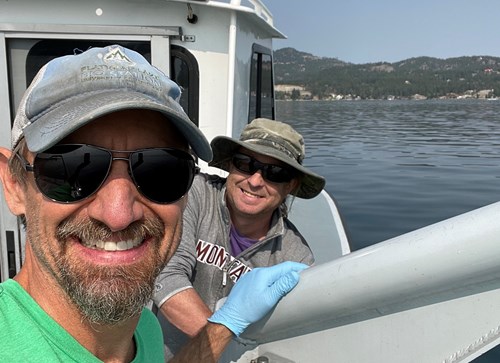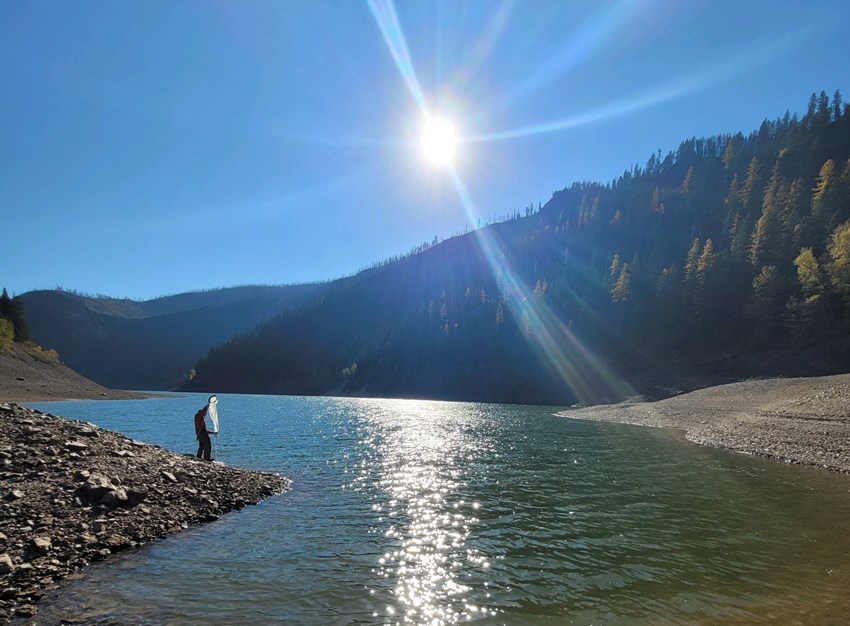Collaborative Effort Continues to Play Critical Role for AIS Prevention in Montana
This year was another important one for Aquatic Invasive Species (AIS) prevention in Montana. Out-of-state visitation remains on the rise, and new residents are moving into the Flathead Watershed and across the state every day. This continued “discovery” of Montana has dramatically increased the risk of invasive mussel infestations in Montana’s waters. This year, 61 mussel-infested watercraft were intercepted at state and tribal boat inspection stations. For those keeping score at home, the previous record, set in 2020, was only 35.
Behind those front lines of prevention at Montana’s boat inspection stations, Flathead Lake Biological Station (FLBS) AIS Specialist Phil Matson and his AIS monitoring team have been busy assisting a rigorous and collaborative statewide early detection survey of our waters. This monitoring is to ensure that—should a mussel-infested boat somehow make it into our waters without getting cleaned, drained, and dried—the invading mussels or other AIS are detected as early as possible.
“This year we collected 645 samples at Flathead Lake and a total of 200 samples at the Tiber Reservoir,” said Matson. “None of those samples have tested positive for invasive mussel larvae, nor have they been positive for evidence of mussel DNA.”
Funded by grants from Montana Department of Natural Resources and Conservation (DNRC) and philanthropic donations, this year Matson’s team completed three rounds of sampling all around Flathead Lake and two rounds of sampling on Tiber Reservoir. Flathead Lake and Tiber Reservoir samples have been shipped to the state AIS lab in Helena for microscopy analysis and to the Bio Station’s Montana Conservation Genomics Laboratory in Missoula for PCR analysis. Tiber samples were also sent to the Bureau of Reclamation’s (BoR) DNA lab for PCR analysis.
At Tiber, a water body that has tested positive for invasive mussels in the past, Matson’s team also used an underwater rover to look for mussels. This was particularly useful in restricted areas along the dam where Montana Fish, Wildlife & Parks (FWP) SCUBA divers cannot survey safely. Additionally, Matson introduced plankton tow net sampling protocols developed by FLBS to FWP and BoR AIS technicians, thus helping to further early detection efforts.
Matson doesn’t work alone. He continues to collaborate closely with the Confederated Salish and Kootenai Tribes (CSKT) and FWP, and also benefits from an incredible team of volunteers. This year, those volunteers included seven Big Sky Watershed Corps members, four FLBS interns, and students from the University of Montana and Salish Kootenai College. Matson strives to build and strengthen connections with additional local, state, and regional partners.

FLBS Research Assistant Leif Howard (right) joined FLBS AIS Specialist Phil Matson (left) on sampling outings and assisted in a new sample decontamination study funded by a grant from the Montana Department of Natural Resources and Conservation.
“Our work to prevent the spread of AIS continues through our working relationships with the Flathead Basin Commission, the Upper Columbia Conservation Commission (UC3), the Western Regional Panel on Aquatic Nuisance Species, and others,” said Matson, who was recently elected Chair of the UC3’s AIS Monitoring Committee. “By providing scientific expertise, we’re able to help develop recommendations for policy, protocol, and best management practices moving forward.”
In addition to overseeing the FLBS AIS monitoring program, Matson also helps promote FWP’s “Clean, Drain, Dry” campaign by disseminating stickers, coloring books, and other informative materials. He also participates in important outreach efforts, like the Mussel Walk for local middle school students, co-hosted alongside CSKT educators, the Flathead Lakers, and Montana State Parks.
The importance of this expansive early detection monitoring and educational outreach can’t be overstated. The Flathead Watershed is within the headwaters of the Columbia River, still the only major river system in the continental US without invasive mussels. Downstream states are watching AIS prevention efforts in Montana very closely. Meanwhile, Tiber Reservoir, in the headwaters of the Missouri River, was listed as “positive” for invasive mussels in 2016. Since then, Tiber has gone five years without another positive detection, and barring another positive sample, is on the brink of being de-listed.
As Matson put it: “Every stone needs to be overturned before Montana de-lists the Tiber Reservoir.”
To help ensure the accuracy of sampling efforts, Matson secured an additional DNRC grant to examine plankton tow net decontamination effectiveness and sample preservation techniques from early detection protocols currently used throughout the western United States. This study will help minimize the potential for false results and wasted resources, and provide insights into the ways sampling protocols can impact the sensitivity for detecting AIS, especially when using the plankton tow net sampling approach. The results of the study were recently presented during the North American Invasive Species Management Association’s annual conference.
“It’s been a busy year, there’s no doubt about it,” said Matson. “But we have a fantastic group of researchers, stakeholders, and legislators here in Montana and throughout the country that understand the importance of prevention. That willingness to collaborate and work together will be critical to keeping our waters free of invasive mussels and other AIS now and in the future.”
For those interested in learning more about the 2021 AIS sampling and boat inspection efforts, Montana FWP maintains an excellent virtual AIS prevention dashboard, which can be found at https://www.arcgis.com/apps/dashboards/4c3ce4d6273e4afd845c165aa111884f


